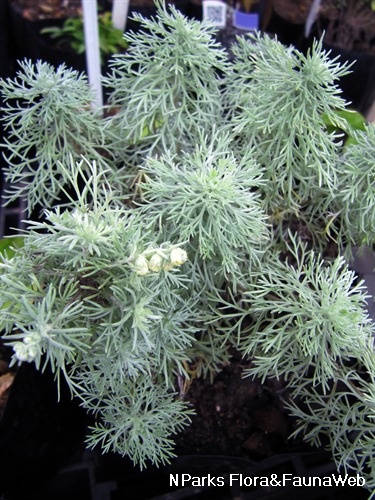
Back
Artemisia lactiflora Wall. ex DC.
| Family Name: | Asteraceae (Compositae) |
| Common Name: | Duck Food Vegetable, White Mugwort, 珍珠菜, 角菜, 白苞蒿 |
Name
Classifications and Characteristics
| Plant Division | Angiosperms (Flowering Seed Plants) (Dicotyledon) |
|---|---|
| Plant Growth Form | Herbaceous Plant, Creeper |
| Lifespan (in Singapore) | Perennial |
| Mode of Nutrition | Autotrophic |
| Plant Shape | Shrubby |
| Maximum Height | 1.5 m |
Biogeography
| Native Distribution | Eastern Asia |
|---|---|
| Preferred Climate Zone | Tropical, Sub-Tropical / Monsoonal |
Description and Ethnobotany
| Others - Plant Morphology | A perennial, upright and much branched shrub that can attain a height of about 1.5 m tall if allowed to grow. Most of the white mugwort plants seen in cultivation grow as a tuft consisting of several non-flowering, low lying rosettes probably due to frequent picking for food. Plants have smooth, slightly glossy, deeply cut leaves that are dark green in colour and are held via reddish purple petioles. The shape of the leaves somewhat shares some resemblence with a duck’s webbed foot. It produces off-white, milky coloured flowers that are borne on plumes.Better grown under semi-shaded and cool conditions and protected from direct tropical sunshine. Grow in well-draining, fertile soil that is constanly kept moist but not soggy. Propagation by means of seeds, stem-cuttings or division. Because seeds are not readily available, the most practical way is to stick a stem tip cutting into a pot of soil obtained from the material bought from the market or taken from an established plant. For each stem cutting, ensure there are several nodes to allow rooting. Crowded, mature clumps can also be dug up, split and planted separately. Newly propagated plants should be given shade and kept moist to take root and recuperate.Plants tend to become straggly and unproductive after repeated harvests. |
|---|---|
| Ethnobotanical Uses | Edible Plant Parts : Edible Leaves Food (Fruit or Vegetable) Others: Leaves are cooked and eaten as a vegetable in a variety of fish dishes to mask the fishy odour. White mugwort is a bitter aromatic tonic herb. The leaves and flowering stems are used internally in traditional Chinese medicine to treat menstrual and liver disorders. |
Landscaping Features
| Desirable Plant Features | Ornamental Flowers |
|---|---|
| Landscape Uses | Container Planting |
Fauna, Pollination and Dispersal
| Fauna Pollination Dispersal Associated Fauna | Bee-Attracting |
|---|
Plant Care and Propagation
| Light Preference | Full Sun |
|---|---|
| Water Preference | Moderate Water |
| Plant Growth Rate | Moderate |
| Rootzone Tolerance | Fertile Loamy Soils, Well-Drained Soils |
| Maintenance Requirements | Moderate |
| Propagation Method | Seed, Stem Cutting, Division |
Foliar
| Mature Foliage Colour(s) | Green |
|---|---|
| Mature Foliage Texture(s) | Smooth, Glossy / Shiny |
| Foliar Type | Simple / Unifoliate |
| Foliar Arrangement Along Stem | Alternate |
| Foliar Margin | Pinnately Lobed / Pinnatifid, Serrate / Toothed |
| Typical Foliar Area | Microphyll ( 2.25cm2 - 20.25 cm2 ) |
| Leaf Area Index (LAI) for Green Plot Ratio | 4.5 (Shrub & Groundcover - Dicot) |
Non - Foliar and Storage
| Stem Type & Modification | Woody |
|---|---|
| Root Type | Underground (Fibrous Root) |
Floral (Angiosperm)
| Flower & Plant Sexuality | Bisexual Flowers |
| Flower Colour(s) | White |
|---|---|
| Inflorescence Type | Panicle |
Image Repository
Others
| Master ID | 391 |
|---|---|
| Species ID | 1687 |
| Flora Disclaimer | The information in this website has been compiled from reliable sources, such as reference works on medicinal plants. It is not a substitute for medical advice or treatment and NParks does not purport to provide any medical advice. Readers should always consult his/her physician before using or consuming a plant for medicinal purposes. |







